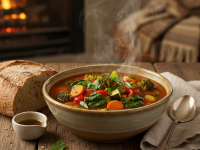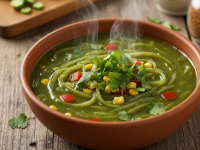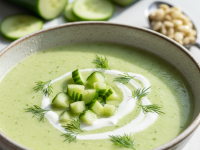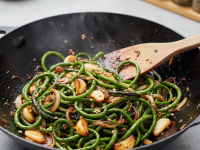Pumpkin Leaf Soup: My Journey from Traditional Comfort to Modern Delicacy
Oh, the humble pumpkin leaf! For many, it’s an ingredient that flies under the radar, perhaps overshadowed by its more famous fruit counterpart. But let me tell you, there’s a world of flavor and nutrition packed into those vibrant green leaves. If you’ve ever had a traditional pumpkin leaf soup, you know the comforting, earthy goodness it brings. It’s a dish that speaks of heritage, of grandmothers’ kitchens, and of simple, wholesome ingredients.
My own journey with pumpkin leaf soup started with those very traditional roots. Growing up, it was a staple, a taste of home that I cherished. But as my palate evolved and my kitchen experiments grew bolder, I found myself wondering: how could I honor that beloved tradition while infusing it with a touch of modern flair? How could I make it sing in a new, exciting way without losing its comforting soul?
That’s exactly what this article is about. I’m going to share my personal recipe for pumpkin leaf soup – one that takes the heart of the traditional dish and gives it a contemporary twist. It’s a recipe born from countless hours in my kitchen, a dash of culinary curiosity, and a deep respect for the ingredients. Get ready to explore a soup that’s both familiar and delightfully new, a dish that I truly believe will become a favorite in your own home.
The Humble Pumpkin Leaf: A Green Powerhouse
Before we dive into the recipe, let’s give a proper introduction to our star ingredient: pumpkin leaves. Often referred to as fluted pumpkin leaves (especially in parts of West Africa where they are incredibly popular), they are so much more than just a garnish or a discarded byproduct. These leaves are a nutritional powerhouse!
They’re rich in vitamins A and C, iron, calcium, and protein, making them an excellent addition to any diet. And the flavor? It’s subtly earthy, slightly sweet, and wonderfully mild, a bit like spinach but with a unique, satisfying texture. The key is in the preparation. When selecting pumpkin leaves, look for vibrant, deep green ones without any signs of wilting or discoloration. They should feel firm and fresh.
Preparing them properly is crucial. First, you’ll need to wash them thoroughly. Then, the most important step: stripping the tough, fibrous strands from the stems and sometimes even the veins of the larger leaves. Just hold the leaf by the stem and peel the fibrous strands downwards. This makes them tender and enjoyable to eat, preventing that stringy texture. Once stripped, stack them, roll them tightly, and slice them thinly into ribbons. Trust me, this little bit of effort makes all the difference!
Echoes of Tradition: My First Tastes
My earliest memories of pumpkin leaf soup are steeped in warmth and family. I remember my grandmother meticulously cleaning and chopping the leaves, her hands moving with practiced ease. The aroma of simmering broth, earthy spices, and sometimes a hint of smoked fish would fill the air, creating an anticipation that no modern dish could ever quite replicate. Her version was simple, hearty, and deeply nourishing – often just the leaves, a robust stock, onions, peppers, and perhaps a touch of palm oil or ground peanuts for richness.
It was a soup that nourished not just the body, but the soul. It taught me the beauty of using fresh, local ingredients and the power of food to bring people together. I learned the importance of patience in cooking, allowing flavors to meld and deepen over time. That authentic taste, that feeling of comfort, is the bedrock upon which my modern version is built. I never want to lose that essence, only enhance it.
Crafting My Modern Twist: What’s New on the Menu?
So, what exactly is my “modern twist” on this beloved classic? It’s about enhancing the creaminess, deepening the aromatics, and adding a subtle complexity that still feels authentic. Here’s what I introduced:
- Coconut Milk: This is perhaps the most significant departure. Traditional versions often use water or meat stock. By incorporating full-fat coconut milk, I achieve an incredibly smooth, luxurious texture and a delicate sweetness that perfectly complements the earthy leaves. It adds a richness without being heavy.
- Fresh Aromatics: While traditional recipes use onions and sometimes peppers, I lean heavily into fresh ginger and garlic. These vibrant aromatics provide a zesty, pungent base that elevates the entire flavor profile, adding warmth and a delightful zing.
- A Touch of Spice (Optional): Beyond just salt and pepper, I sometimes add a pinch of smoked paprika or a very mild chili flake to introduce a subtle layer of smokiness or heat, depending on my mood. This isn’t about making it fiery, but about adding depth.
- Protein Choices: While a purely vegetarian version is fantastic, I often enjoy adding a protein. Instead of traditional smoked fish, I might opt for pan-seared shrimp, shredded grilled chicken, or even some crumbled feta or roasted chickpeas stirred in at the end for a vegetarian boost. This makes it a more complete meal.
The goal isn’t to reinvent the wheel, but to polish it, making it shine even brighter for a contemporary palate while respecting its origins. It’s about finding that sweet spot where heritage and iovation happily coexist.
Gathering Your Flavor Arsenal: Ingredients You’ll Need
Ready to get cooking? Here’s what you’ll need for my modern pumpkin leaf soup. Remember, fresh ingredients make all the difference!
- 2 large bunches (about 1 lb or 450g) fresh pumpkin leaves, stripped and finely sliced
- 1 tablespoon olive oil or coconut oil
- 1 large yellow onion, finely chopped
- 3-4 cloves garlic, minced
- 1-inch piece fresh ginger, grated or minced
- 4 cups (1 liter) vegetable broth or chicken broth
- 1 can (13.5 oz / 400ml) full-fat coconut milk
- 1/2 cup water (or more broth, as needed for consistency)
- 1/2 teaspoon smoked paprika (optional)
- Salt and freshly ground black pepper to taste
- Optional: Cooked shrimp, shredded chicken, or crumbled feta for serving
- Optional Garnish: Fresh cilantro or parsley, a swirl of coconut cream
Let’s Get Cooking! My Step-by-Step Guide
Alright, apron on, and let’s bring this beautiful soup to life in your kitchen!
- Prepare the Pumpkin Leaves: This is your first and most important step. As mentioned, wash your pumpkin leaves thoroughly. Then, meticulously strip away all the fibrous strands from the stems and larger veins. Stack the cleaned leaves, roll them tightly, and slice them into very thin ribbons. Set aside.
- Sauté the Aromatics: Heat the olive oil in a large pot or Dutch oven over medium heat. Add the chopped onion and cook until softened and translucent, about 5-7 minutes.
- Awaken the Flavors: Add the minced garlic and grated ginger to the pot. Sauté for another 1-2 minutes until fragrant, being careful not to burn the garlic. If using smoked paprika, add it now and stir for about 30 seconds to release its aroma.
- Add Liquids: Pour in the vegetable or chicken broth, coconut milk, and 1/2 cup of water. Stir everything together. Bring the mixture to a gentle simmer.
- Introduce the Leaves: Once simmering, add the sliced pumpkin leaves to the pot. They will look like a lot, but they will wilt down significantly. Stir them into the liquid. Cover the pot and let it simmer for about 10-15 minutes, or until the pumpkin leaves are tender. Don’t overcook them; you want them soft but still vibrant.
- Season and Taste: Remove the pot from the heat. Season generously with salt and freshly ground black pepper. Now, here’s where your palate comes in – taste and adjust. Do you need a bit more salt? A touch more pepper? Perhaps a tiny squeeze of lime juice for brightness?
- Blend for Creaminess (Optional but Recommended!): For that wonderfully smooth, luxurious texture, I highly recommend blending a portion of the soup. Carefully transfer about 2-3 cups of the soup to a blender (be cautious with hot liquids – fill only halfway and hold the lid firmly). Blend until smooth, then stir the blended portion back into the pot. If you prefer a chunkier, more rustic soup, you can skip this step entirely.
- Final Touches and Serve: If you’re adding protein, stir in your cooked shrimp, shredded chicken, or crumbled feta now and heat through for a couple of minutes. Ladle the hot soup into bowls. Garnish with fresh cilantro or parsley and, if you’re feeling fancy, a small swirl of extra coconut cream.
Pro Tips & Flavor Boosters
- Don’t Skip the Stripping: Seriously, those fibrous strands are no fun to chew on. Take the time to prepare the leaves properly.
- Adjust Consistency: If your soup is too thick, add a little more broth or water until it reaches your desired consistency. If it’s too thin, you can simmer it uncovered for a few extra minutes, or for a quick fix, blend in a tablespoon of cornstarch mixed with a little cold water.
- Spice It Up (or Down): If you love a bit of heat, add a pinch of cayee pepper or a small, deseeded Scotch Boet pepper (carefully!) along with the aromatics. For a milder soup, simply omit the paprika.
- Storage: This soup tastes even better the next day! Store leftovers in an airtight container in the refrigerator for up to 3-4 days. It also freezes well for up to 3 months.
- Serving Suggestions: This soup is wonderfully versatile. Serve it as a light meal with crusty bread for dipping, alongside a scoop of rice, or as a vibrant accompaniment to grilled fish or chicken.
Conclusion
And there you have it – my treasured recipe for pumpkin leaf soup, a dish that beautifully marries the comforting embrace of tradition with the exciting possibilities of modern cooking. It’s more than just a recipe; it’s a story, a journey from childhood memories to culinary exploration, all centered around an ingredient that truly deserves its moment in the spotlight.
I hope you feel inspired to try this recipe in your own kitchen. Don’t be afraid to experiment, to make it your own, and to savor the rich flavors and nourishing goodness that come from coecting with food in such a meaningful way. This soup is a testament to the idea that some of the best culinary adventures happen when we honor our past while daring to taste the future. Happy cooking!




